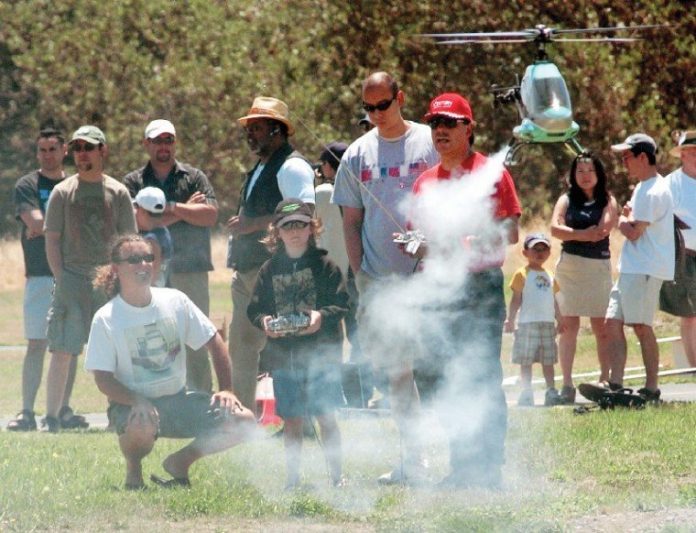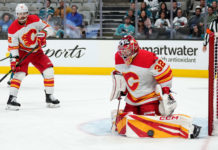The F-18 Hornet took off in a roar, and the weekend crowd roared
along with it. It shot up vertically into the deep blue sky leaving
behind a soft trail of fumes as heads bent skyward. When it swooped
down 15 feet off the ground on a pass at nearly 200 miles an hour,
heads snapped along.
By Perry Shirley staff writer
Morgan Hill – The F-18 Hornet took off in a roar, and the weekend crowd roared along with it. It shot up vertically into the deep blue sky leaving behind a soft trail of fumes as heads bent skyward. When it swooped down 15 feet off the ground on a pass at nearly 200 miles an hour, heads snapped along.
Still a couple of minutes away from the Santa Clara Model Aircraft Skypark where the action was taking place, children with their parents riding a parking lot shuttle stopped what they were doing and listened intently to the jet’s roar. The sharp-eyed youngsters picked up the zooming black dot in the air and plastered their faces to the windows, all shrilly voices and pointed fingers.
Soon enough they would get a real good look at the radio-controlled jet, one-fifth the size of the real thing but ripping through the sky with an identically scaled turbine engine – at a price tag of $20,000.
“A lot of people wouldn’t feel comfortable putting so much money into the air but they are here to fly,” said Dave Presta, piloting the F-18 from the ground.
Model aircraft hobbyists got to show off some expensive toys, and plenty of affordable propeller-powered planes, helicopters, flying objects and even tanks during Saturday and Sunday’s airshow at the Skypark north of Morgan Hill off U.S. 101. Between both days, which had similar five-hour schedules, roughly 2,200 people ventured out to watch, prod and play with models.
“We don’t want to be a sport that shuts people out, we want to bring people in,” said club member George Black. “The hope is that they get excited about the hobby, have a good time and maybe try it for themselves.”
Noontime was the most exciting for youngsters who were given a few minutes at the controls of simple planes or helicopters.
Six-year-old James Dean of San Jose was lucky enough to try both and said he preferred planes because “they went so much higher up.” He listened intently to an instructor who sat ready at all times to take over piloting duties with his own, linked controller in case of emergency.
Crashes are fairly common with this hobby, but as one helicopter pilot, Julius Chisolm of Morgan Hill, said, “if you don’t crash it’s because you are not trying to fly.” He recalled the airshow two years ago when he was finishing a routine with one of the seven helicopters he owns. Coming down to the landing pad, instead of turning the model around, he turned it over and pulverized the $700 machine to pieces.
Because they stay firmly grounded, radio-controlled tanks are the preferred investment for some model enthusiasts. Six of them were on display at the airshow, mostly centered around a scale village that served as the ground for World War II reenactments of fights between the American Sherman tanks and the German Hunting Panthers.
The tanks fought using laser beam-equipped canons, trying to hit electronic targets on other tanks. Once hit, the tanks made painful lurching noises and moved slower, the realistic electronics mimicking real combat destruction.
Working scale models, whether flying or grounded, often have varying attributes that mirror precisely their real-life, full-scale brethens. Rich Upton of the Bay Area Tankers Radio Controlled Armor Club regaled in showing off the advanced, super supple suspension on his $400 Hunting Panther tank that enabled it to navigate bumpy tall grass fields the stiffer Sherman tanks could not.
While some might argue that radio-controlled flying is a specialized field, there are cliques even within the hobby. The South Bay Soaring Society was well represented and given a time slot to showcase gliders – model planes with no motors that stand much closer to birds in their operation than engine-powered flyers.
Gliders were easily the lightest, simplest and cheapest model aircraft on display. But even a $150 model can soar to 2,000 feet after being slingshot into the air by a powerful launching motor. Operators look to circling turkey vultures for clues as to where the gliders can catch swirling air vortexes that act like air elevators for both bird and machine.
“It’s a skill of catching Mother Nature’s air lift without power and having fun with it,” gliding enthusiast Tim Condee said.
Slapsticks were also part of the show.
While one set of planes was being prepped to come down a runaway, a man went out to the take-off strip with a red-and-black lawnmower. When called out by the airshow’s announcer he began to run only to see the mower push ahead of him and take to the air. Children in the audience seemed to particularly enjoy the surreal sight of a full-size mower, flying gear hidden, not just making passes but doing aerobatics as well.
In all, families mostly left the field satiated, the children dreamily playing with the free wooden glider planes they were given. Steve Raiff of Mountain View brought his three small children, still excited from a recent vacation trip in an airliner, to the airshow with him. One of them dropped his model airplane and chipped off a piece of the wing. He frowned, and thought for a moment, then smirked and shrugged his shoulder: Soon he would throw it and it would soar like a jet plane.
Perry Shirley is a news intern who attends San Francisco State University. He can be reached at (408) 846-6452 or ps******@**********rs.com.















